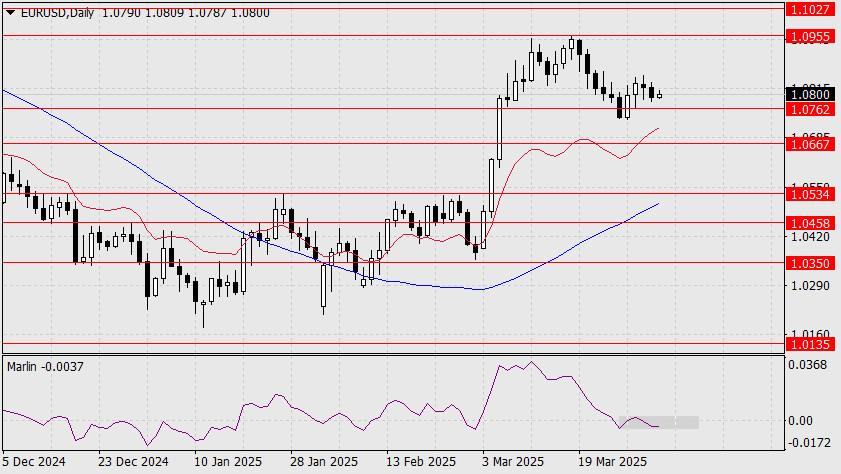Veja também


 02.04.2025 04:49 AM
02.04.2025 04:49 AMBy the end of yesterday, the euro fell by 25 pips, but risk appetite in the market continued to grow: the S&P 500 rose 0.38%, the yield on 5-year U.S. government bonds held steady for the third day at 3.95%, and the dollar index posted a symbolic gain of just 0.03%. However, PMI indexes from both the eurozone and the U.S. favored the American economy, and as expected, investors reacted accordingly, mainly ignoring the eurozone's drop in unemployment and inflation figures. The eurozone's Manufacturing PMI rose from 47.6 to 48.6 (below the forecast of 48.7), while the U.S. Manufacturing PMI dropped from 52.7 to 50.2, better than the expected 49.8.
Markets (if you believe the U.S. Democratic media) assume the reciprocal tariffs will harm the U.S. more, as Europe is expected to benefit from increased infrastructure and military spending. However, we do not support this view. Broader infrastructure projects began developing in the U.S. much earlier—during Obama's last presidential term—and in May, a decisive new phase of QE by the U.S. Treasury is set to begin to boost domestic manufacturing. This plan was delayed under Biden, and Trump now intends to compensate for lost time. We believe the real economy, as reflected in the PMI data, remains optimistic. Friday's U.S. employment data for March will carry strategic weight.
On the daily chart, the signal line of the Marlin oscillator is starting to wind around the zero line. Price may consolidate above the 1.0762 support level. Risk appetite and buying pressure for the euro remain strong, so we maintain our scenario of a rise toward 1.0955 and potentially to 1.1027 as the main outlook. A sustained move below 1.0762 could still push the price down to 1.0667.
On the H4 chart, the Marlin oscillator is also neutral, while the price is developing above the balance line (red MA). The pair could gradually decline to the 1.0762 support without breaking below the balance line, then rebound and head higher through the MACD line. Whether the rally begins from current levels or a rebound off support, the condition for further growth will be a consolidation above the MACD line. Today, this level is at 1.0816. Tomorrow, it could shift to 1.0800.
You have already liked this post today
*A análise de mercado aqui postada destina-se a aumentar o seu conhecimento, mas não dar instruções para fazer uma negociação.
Com a presença de uma divergência entre o movimento de preços do par AUD/JPY e o indicador Stochastic Oscillator, além do preço estar acima da média móvel ponderada (WMA)
Ao observar o gráfico de 4 horas, o ouro ainda apresenta viés de alta. No entanto, a divergência entre o movimento de preços do ouro e o indicador Stochastic Oscillator
Ao analisarmos o gráfico de 4 horas do par cruzado GBP/CHF, observamos diversos elementos interessantes. Primeiramente, o surgimento de um padrão de triângulo, aliado ao movimento
Com o par AUD/CAD se movendo acima da média móvel ponderada de 21 períodos (WMA 21), que apresenta inclinação positiva, e com a ocorrência de convergência entre o movimento
Com base na análise do gráfico de 4 horas do índice Nasdaq 100, destacam-se três pontos principais: primeiro, o movimento dos preços ocorre abaixo da média móvel de 100 períodos
Vídeo de treinamento

Your IP address shows that you are currently located in the USA. If you are a resident of the United States, you are prohibited from using the services of InstaFintech Group including online trading, online transfers, deposit/withdrawal of funds, etc.
If you think you are seeing this message by mistake and your location is not the US, kindly proceed to the website. Otherwise, you must leave the website in order to comply with government restrictions.
Why does your IP address show your location as the USA?
Please confirm whether you are a US resident or not by clicking the relevant button below. If you choose the wrong option, being a US resident, you will not be able to open an account with InstaTrade anyway.
We are sorry for any inconvenience caused by this message.


